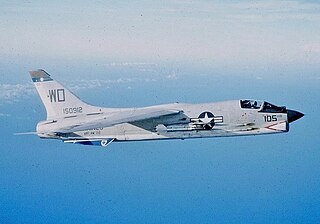
The Vought F-8 Crusader is a single-engine, supersonic, carrier-based air superiority jet aircraft designed and produced by the American aircraft manufacturer Vought. It was the last American fighter that had guns as the primary weapon, earning it the title "The Last of the Gunfighters".

Strike Fighter Squadron 211 (VFA-211), nicknamed the "Fighting Checkmates", is an aviation unit of the United States Navy established in 1945. The squadron is based at Naval Air Station Oceana and is equipped with the Boeing F/A-18E Super Hornet.
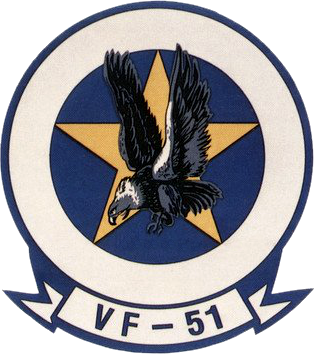
VF-51, Fighter Squadron 51 was an aviation unit of the United States Navy known as the "Screaming Eagles". It was originally established as VF-1 on February 1, 1943, redesignated as VF-5 on July 15, 1943, redesignated as VF-5A on November 15, 1946, redesignated VF-51 on August 16, 1948, and disestablished in March 1995. Until its disestablishment, VF-51 was the oldest fighter squadron in continuous service with the Pacific Fleet.

Fighter Squadron 114 (VF-114) was a fighter squadron of the United States Navy that was active from 1945 through 1993. Nicknamed the "Aardvarks", it was based out of Naval Air Station Miramar, California. The squadron flew combat missions during the Korean War and Vietnam War. VF-114 was disestablished as part of the post-Cold War drawdown of forces on April 30, 1993.

Fighter Squadron 194 (VF-194) was an aviation unit of the United States Navy. It was originally established as VF-91 on 26 March 1952, redesignated VF-194 on 1 August 1963 and disestablished on 1 March 1978. It was the third US Navy squadron to be designated VF-194.

Fighter Squadron 53, or VF-53Iron Angels was an aviation unit of the United States Navy in service from 20 July 1950 to 29 January 1971. Originally established as reserve squadron VF-721 on 20 July 1950, it was redesignated as VF-141 on 4 February 1953 and then redesignated as VF-53 on 15 October 1963. The squadron was disestablished on 29 January 1971. It was the fourth US Navy squadron to be designated as VF-53.

Light Photographic Squadron 62 (VFP-62) was an aviation unit of the United States Navy in service from 1949 to 1968. The squadron provided a detachment of reconnaissance planes for each of the carrier air wings of the U.S. Atlantic Fleet.
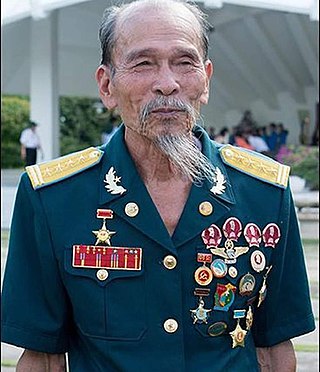
Nguyễn Văn Bảy, was a Vietnamese jet fighter ace for the Vietnam People's Air Force during the Vietnam War. Piloting a MiG-17F while assigned to the 923rd Fighter Regiment, Bay claimed 7 aerial combat victories while engaged against aircraft of the USAF and USN: 2 F-8s, 1 F-4B, 1 A-4C and 1 F-105D. Of the 7 claimed victories, 5 are acknowledged by American documents. Of 16 VPAF aces during Vietnam War, only Bay, Luu Huy Chao, and Le Hai solely flew MiG-17s.

Electromagnetic Attack Squadron 130 (VAQ-130), also known as the "Zappers", is an EA-18G Growler squadron of the United States Navy based aboard Naval Air Station Whidbey Island. Part of Carrier Air Wing 3, the Zappers deploy aboard the aircraft carrier USS Dwight D. Eisenhower. VAQ-130 is the oldest electromagnetic warfare squadron in the U.S. Navy.

Electromagnetic Attack Squadron 131 (VAQ-131), also known as the "Lancers," is a United States Navy tactical jet aircraft squadron specializing in kinetic and non-kinetic Suppression of Enemy Air Defenses (SEAD). They are based at Naval Air Station Whidbey Island, flying the EA-18G Growler. Their radio callsign is "Skybolt."

VFA-161, nicknamed the Chargers, was a Strike Fighter Squadron of the U.S. Navy. It was established at NAS Cecil Field as Fighter Squadron VF-161 on 1 September 1960. It moved to NAS Miramar on 19 September 1961, and to Naval Station Yokosuka, Japan. On 1 April 1986, the squadron was redesignated VFA-161. It was disestablished on 1 April 1988.

RVAH-1 was a Reconnaissance Attack (Heavy) Squadron of the U.S. Navy. Originally established as Heavy Attack Squadron One (VAH-1) on 1 November 1955, it was redesignated as Reconnaissance Attack (Heavy) Squadron One (RVAH-1) on 1 September 1964. The squadron was disestablished on 29 January 1979.
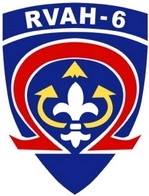
RVAH-6 was a Reconnaissance Attack (Heavy) Squadron of the U.S. Navy. Originally established as Composite Squadron Six (VC-6) on 6 January 1950, it was redesignated as Heavy Attack Squadron Six (VAH-6) on 1 July 1956 and was redesignated as Reconnaissance Attack (Heavy) Squadron Six (RVAH-6) on 23 September 1965. The squadron was disestablished on 20 October 1978.

RVAH-13 was a Reconnaissance Attack (Heavy) Squadron of the U.S. Navy. Originally established as Heavy Attack Squadron Thirteen (VAH-13) on 3 January 1961 it was redesignated as Reconnaissance Attack (Heavy) Squadron Thirteen (RVAH-13) on 1 November 1964. The squadron was disestablished on 30 June 1976.

RVAH-5 was a Reconnaissance Attack (Heavy) Squadron of the U.S. Navy. Originally established as Composite Squadron Five (VC-5) at Naval Air Station Moffett Field, California on 9 September 1948, it was redesignated as Heavy Attack Squadron Five (VAH-5) on 1 November 1955 and was later redesignated as Reconnaissance Attack (Heavy) Squadron Five (RVAH-5) in May 1964. The squadron was disestablished on 30 September 1977.
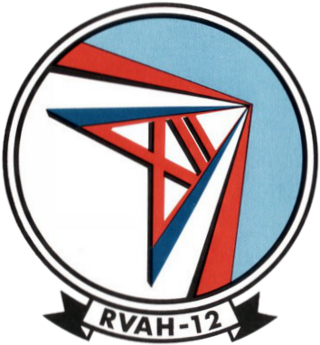
RVAH-12 was a Reconnaissance Attack (Heavy) Squadron of the U.S. Navy. The squadron was established on 1 July 1965 and disestablished on 2 July 1979.
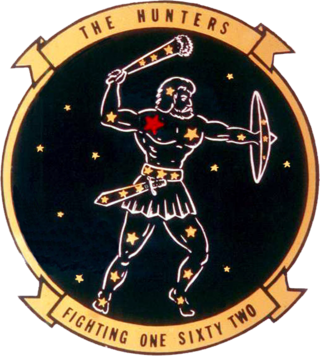
Fighter Squadron 162 or VF-162 was an aviation unit of the United States Navy established on 1 September 1960 and disestablished on 29 January 1971.

Fighter Squadron 111 (VF-111), also known as the Sundowners, was a fighter squadron of the United States Navy. Originally established as Attack Squadron 156 (VA-156) on 4 June 1955, it was redesignated VF-111 on 20 January 1959, the day after the original VF-111 was disestablished. The squadron was redesignated VF-26 on 1 September 1964, redesignated as VF-111 on 17 September 1964 and disestablished on 31 March 1995.

Marine Composite Reconnaissance Squadron 1 (VMCJ-1) was an aviation squadron of the United States Marine Corps that provided aerial photographic reconnaissance and electronic countermeasures is support of the Fleet Marine Force. The squadron was formed in 1958 with the merger of Marine Composite Squadron 1 (VMC-1) and Marine Photo Reconnaissance 1 (VMJ-1). The squadron's support to the Vietnam War began in 1964 flying off Yankee Station and ended with sorties in support of Operation Frequent Wind during the fall of Saigon. VMCJ-1 was decommissioned in 1975 as the Marine Corps further consolidated its aerial photo reconnaissance assets after the Vietnam War.
























